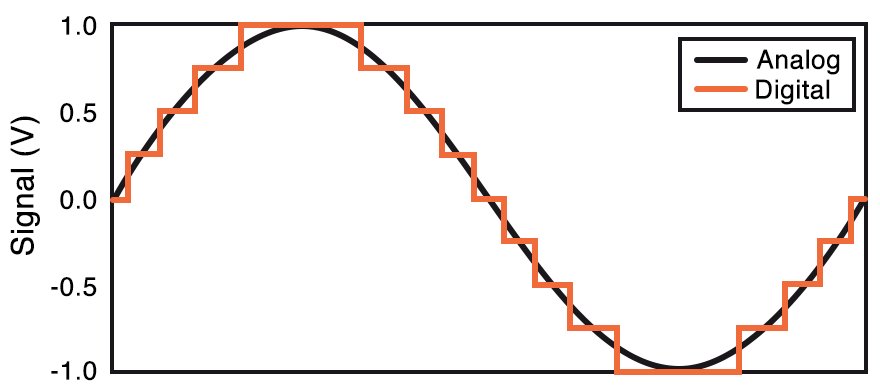In the previous tutorial, we discussed the difference between analog and digital ICs, and now we’re ready to look at specific types of integrated circuits that play an important role in many electronic systems. However, you probably noticed that we have introduced a third category: in addition to analog and digital ICs, we have mixed-signal ICs. As the name implies, mixed-signal components include analog and digital circuitry in the same package. This combination can produce sophisticated, highly integrated functionality that makes a vital contribution to the design of modern electronic devices.
Digital ICs
Nowadays, purely digital integrated circuits are less common than one might think. Digital circuitry is frequently incorporated into microcontrollers or application-specific integrated circuits (ASICs) that include analog circuitry as well, which means that they belong in the mixed-signal category.
Logic
Discrete logic, though somewhat outdated, is still manufactured and used. This term refers to individual logic gates as well as low-complexity logic-gate-based devices such as flip-flops, multiplexers, counters, and registers.
One reason for the diminished importance of discrete logic is the higher performance and efficiency offered by complex programmable logic devices (CPLDs) and field-programmable gate arrays (FPGAs). These ICs allow an engineer to implement customized digital functionality by “writing” a circuit using a hardware description language (HDL) and then loading configuration data into the device.

This is an example of an FPGA development board.
Memory
Memory is a crucial element of digital and mixed-signal systems. Different types of memory include dynamic random-access memory (DRAM), static random-access memory (SRAM), and non-volatile memory such as flash. Though flash and RAM are present in countless electronic devices, memory ICs are not particularly common because memory is frequently integrated into other types of devices.
Processors
Microprocessors are advanced computational devices that represent the apogee of digital circuit design. Electrical engineers frequently work with two types of processor ICs: microcontrollers, which include various peripherals such as analog-to-digital converters, timers, and communication modules; and digital signal processors (DSPs), which are optimized for mathematical operations.

This diagram conveys the difference between a central processing unit (CPU), a processor, and a microcontroller. Refer to this article for more information.
Analog ICs
Perhaps the most widespread and foundational analog IC is the operational amplifier (op-amp). These highly versatile devices are used for much more than basic signal amplification, and manufacturers have produced a vast selection of devices with different features, package sizes, and performance specifications. The next chapter in this series of video tutorials provides an abundance of information on the characteristics and applications of op-amps.

This op-amp will perform non-inverting amplification.
Op-amps are not the only important category of amplifier ICs. Instrumentation amplifiers have a differential input, and various types of specialized amplifiers are used in, for example, sensor, audio, video, and industrial systems. Comparators are amplifiers that are designed to produce a digital output—that is, the output voltage reacts to input signals by moving all the way to the positive supply voltage or all the way to the negative supply voltage.
Voltage reference ICs generate a precise, stable voltage and are frequently used in conjunction with data converters (which are discussed in the next section), and analog filter ICs (also often paired with data converters) provide high-performance frequency response. Analog switches and analog multiplexers allow designers to conveniently control or route analog signals.
A special class of analog ICs are those that function at high (or extremely high) frequencies and are intended for wireless communication devices. These RF (radio frequency) integrated circuits include mixers, low-noise amplifiers (LNAs), and power amplifiers (PAs).
Mixed-Signal ICs
There isn’t much to say about this category of ICs, because common mixed-signal devices simply combine functionality from the common analog and digital devices that we have already discussed.
However, we do need to mention the two devices that form the foundation of mixed-signal circuitry: data converters. These devices make it possible to use digital processing in an analog world, because they convert data from the analog realm to the digital realm and vice versa. An analog-to-digital converter (ADC) accepts a continuously varying input voltage and repeatedly approximates the analog voltage using binary numbers; a digital-to-analog converter (DAC) accepts binary numbers as input data and generates a corresponding analog waveform.

This plot conveys the difference between an analog signal and a digital approximation of that signal.
Conclusion
We’ve taken a brief look at the world of analog, digital, and mixed-signal ICs. However, we still need to discuss one more extremely important category of integrated circuits: those that help us supply power to our circuits. Power ICs will be the subject of the next tutorial.


